Creating a Heavy Metal Theme Garden
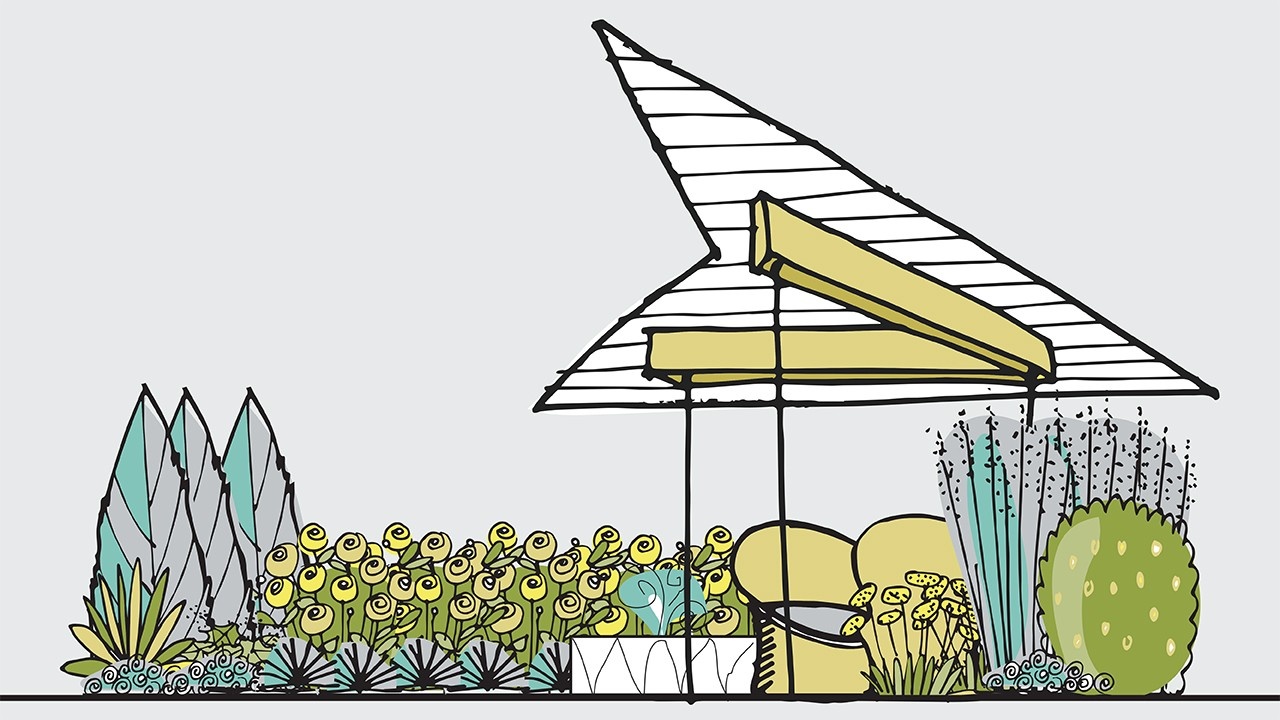
About 15 years ago I accepted an amazing position at a local botanic garden. Being in a beautiful place, surrounded by talented staff and volunteers inspired the creation of my theme garden development process. We applied it to the botanic garden displays many times, then I eventually realized it would also be perfect for homeowners too. Awesome.

I've been sharing this process with hundreds of people at conferences and garden club meetings with positive results. New designers gain insight into creating a special outdoor space, while experienced designers say they are filled with new inspiration towards the design process. Think of it as the first step towards planning your future garden. It's fun, easy and a great way to start dreaming about your outdoor space.

My theme garden process steps beyond typical themes like butterfly and moon gardens (though those are nice!). This process instead shows how to design a garden about anything (really). Maybe you collect Fiestaware or have an obsession with the wild west...either can inspire your outdoor space.
This process takes place by following five steps...with lots of inspiration along the way.
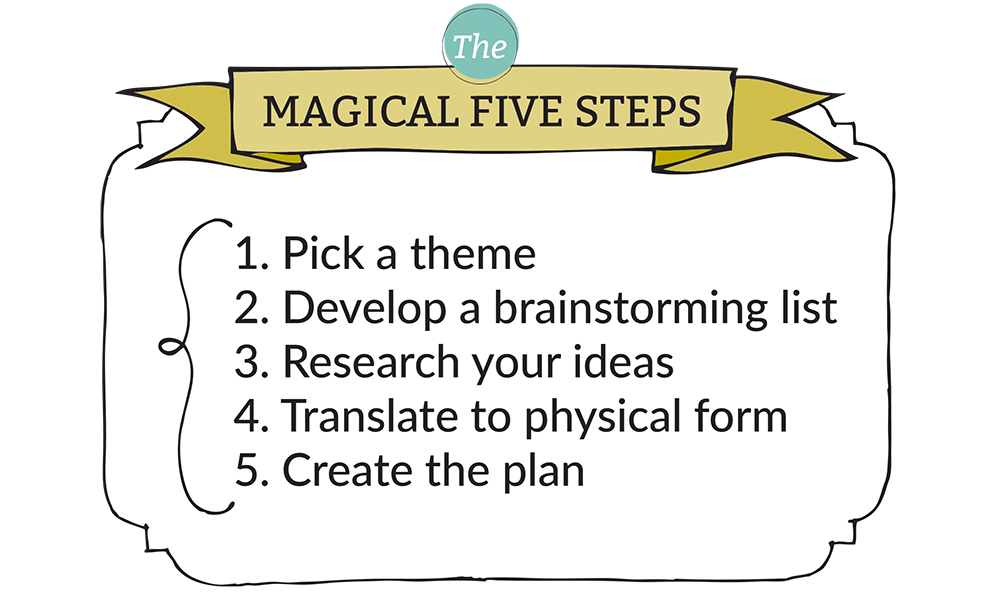
STEP ONE | PICK A THEME
A THEME is the idea that pulls all the elements of a garden together. Before designing a garden I always encourage the selection of a theme. Why?
-
To focus your design
-
To help in the selection of materials (plants, hardscapes, furniture, etc.)
-
To tell a story
Designing a garden is similar to writing a paper. Before you write it's important to choose a topic, then have the content support it. You can write about thousands of things, but the topic helps you focus. This is the same in garden design. There are thousands of ways to design your garden, but by narrowing in on a topic or theme, choices become a lot easier. Honestly, it's a lot more fun too and your creativity just spills over.
First let's look at some traditional themes:
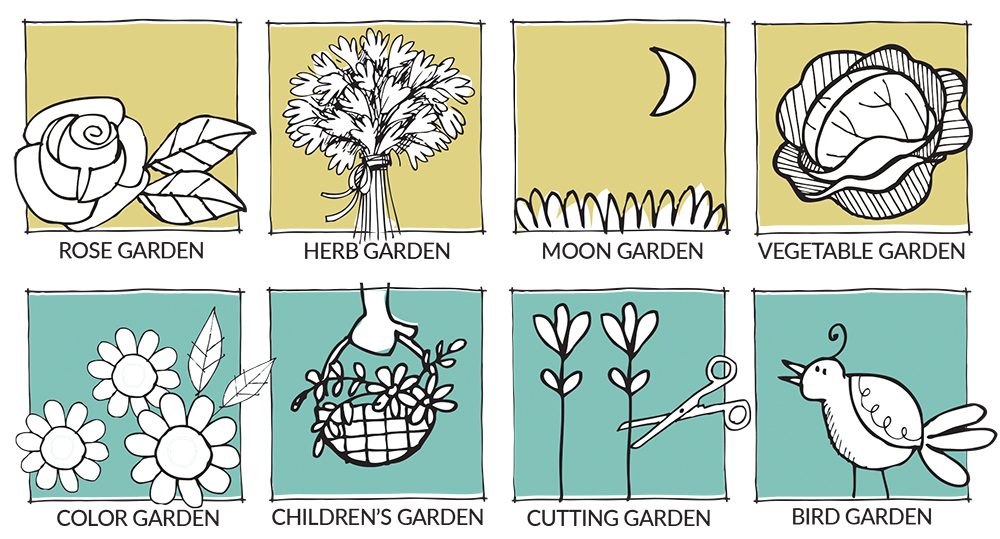
Traditional themes are great, but I'd like to show you how to develop a garden around any theme. Our garden will focus on something nontraditional and out-of-the-ordinary. Perhaps something like shoes, fashion, heavy metal, pez, photographs, ceramics, music, video games, murder mystery books, jeans, wellies, Christian Louboutan red sole shoes, punk, jazz, Great Gatsby, Italy and quilts. Wow! So many options!
Below are garden themes that can be created from some of these ideas.

The most fascinating themes have no relationship to gardening. When you combine gardening with an unrelated topic the design gets very interesting (I'm getting goosebumps just thinking about it!).
Now to pick a theme (drum roll please...). I'd like to choose something that seems far, far away from gardening (to show that this can indeed be accomplished), be a topic I'd like to learn more about, and finally something that will challenge me outside my illustrative comfort zone (opposite of cute and whimsical). The only logical choice is HEAVY METAL!
I'm a little frightened, but excited to get started!
When I developed this theme many years ago, my then eleven-year-old daughter said to me...mom, how are you going to create a heavy metal garden? My reply..."not sure, but I plan to follow the process to find out." I typically don't have preconceived ideas, I just let the process inspire me.
STEP TWO | BRAINSTORMING
Now that we have a theme (heavy metal) it's time to start transforming it into a garden. Brainstorming is an important step in this process.
What is brainstorming?
-
generating a list of words/ideas around one topic
-
free-flow, no bad ideas
-
by yourself okay, but more people generate more ideas
I can't stress this enough...make this list as long as possible. Please don't write down three things then stop. Challenge yourself to write down 50 words! If you're stuck, call a friend and have them add to it. Remember, these don't have to relate to gardening...just your theme.
With some help I created a fabulous brainstorming list below.

STEP THREE | RESEARCH
The research step helps lengthen our idea list. Research allows you to find out more about your topic....things you wouldn't necessarily know off the top of your head. It makes your design so much richer. You can put as much time into this step as you'd like...visit a library, interview an expert or simply Google your topic. Ten minutes or ten hours, but it's important that you don't skip this step. It often leads to amazing ideas.
Below is my very simple research on heavy metal. I apologize up front for the condensed version. I could have written a 25 page paper on this topic, but for this purpose a broad, bulleted overview will do.
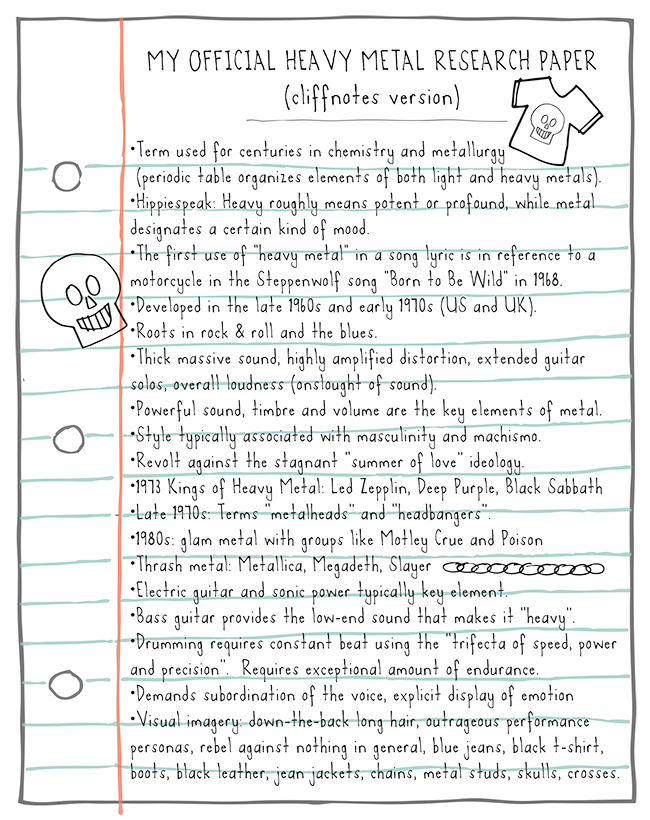
I'd like to thank www.hardradio.com and, of course, www.wikipedia.com for this information. Visit both sites if you'd like to learn more.
Now that we have our brainstorming and research lists complete it's time to start designing! Woo-hoo!
STEP FOUR | TRANSLATE IDEAS TO PHYSICAL FORM
We have finally reached the most exciting step (aside from making the final plan). This is when we get to take all those great ideas and create the garden components. This step will also take the longest because we have a lot to pick out....including:
color + structure + hardscapes + furniture + ornamentation + plant materials

COLOR
The first part of this step is choosing colors for our theme garden. Our color palette will help us choose furniture, plants, hardscapes, fabrics, etc. We do this by sifting through our brainstorming and research lists for clues of color choices. I've decided to use this as our heavy metal color palette:

The black is from the dark and moody atmosphere, plus black leather jackets. The gray reflects chains, smoke, silver, and metal, while the yellow is my less-shiny translation of gold and flashy stage lights (it could also be the background of animal prints).
Something you should know...in the garden world there are two neutral colors: green and white. Of course, green will always be in your garden through lawn and leaves, so just consider this a given. You can also sneak in a bit of white for accent if you'd like. Make sure you put more emphasis on your main color palette though and don't rely on white too much (unless white is one of your theme colors!).
.....
STRUCTURE IN THE GARDEN
Before jumping into the structure for our heavy metal garden, I'd like to give you a broad overview of this concept first.
The structure of a garden is how one gives form to an outdoor space. Rather than placing things willy-nilly, structure will encourage strong lines and reinforce your theme.
To simplify things, think of this structure on the ground plane. Imagine looking at your garden from above in the winter (when the plants are no longer the dominant focus). What shapes and lines would you see?
Another way to visualize structure is thinking about the shape of your lawn or patio. This space should be a strong space that can be easily seen.
To establish strong structure think about will your space be FORMAL or INFORMAL?

Will your space incorporate a circle like a circle, square or oval?

Will your space be inspired by a certain garden style like French, Japanese or Mid-Century Modern?

Now let's think about our heavy metal concept once again. If we look at our brainstorming and research lists does anything stand out to you that might give our garden structure? This is what I found as possibilities:
ripped jeans/blue jeans = straight lines, jagged lines
stage/lights = half circle or full circle
drums = circles or two circles for double bass drums
chains = interlinked spaces
motorcycles = circles, spokes
walkmans = squares with squiggly lines for wire
tour bus = rectangle, circles
beer bottles = bottle shape or circle for cap
guitar/flying v = guitar or v shape
posters = rectangle
skulls = skull shape
periodic table = grid
t-shirts = t-shirt shape
trifecta of speed, power and precision = use three of something
late 1960s/early 1970s = use a garden style from this period, probably clean, simple lines
This is a long list of possible structure ideas for our garden and we definitely will not use them all, but I wanted to show what our initial brainstorming and research lists provide for inspiration. It really is amazing.
.....
HARDSCAPES
Hardscape typically encompass non-living permanent materials. These can include paving, arbors, pergolas, walls, trellises, fences, gazebos, and whatever other garden architecture you can dream up.
Try to think in three dimensions when considering hardscapes, since you are creating a garden space. An easy way to conceptualize this is in terms of a floor, walls, and ceiling.
Take a shape or two from our structure list and try converting those to a hardscape element, plus think about how our colors can be translated to a hardscape material.
Let's start with the garden floor (paving, for instance). For fun, let's take the idea of heavy metal posters. I want to show how you can take one of the shapes from our list in garden structure then translate it into a hardscape. I'm picking a simple shape, but you can also do this with the shape of a skull, jeans, chains or anything from our list.
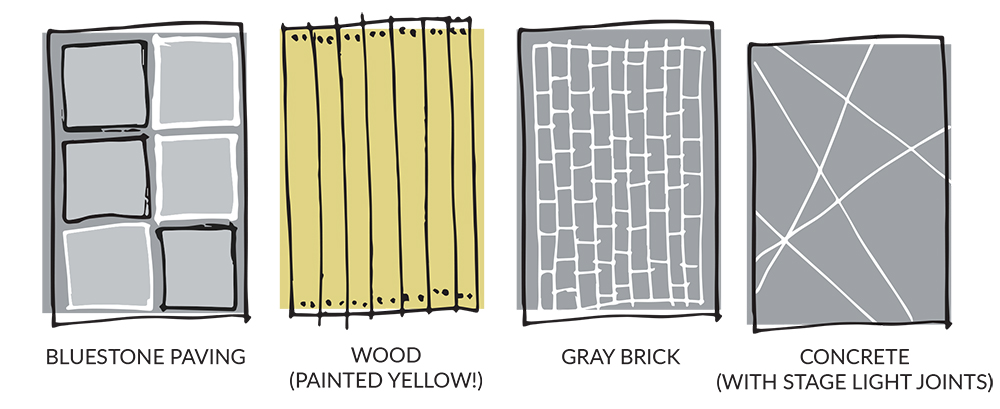
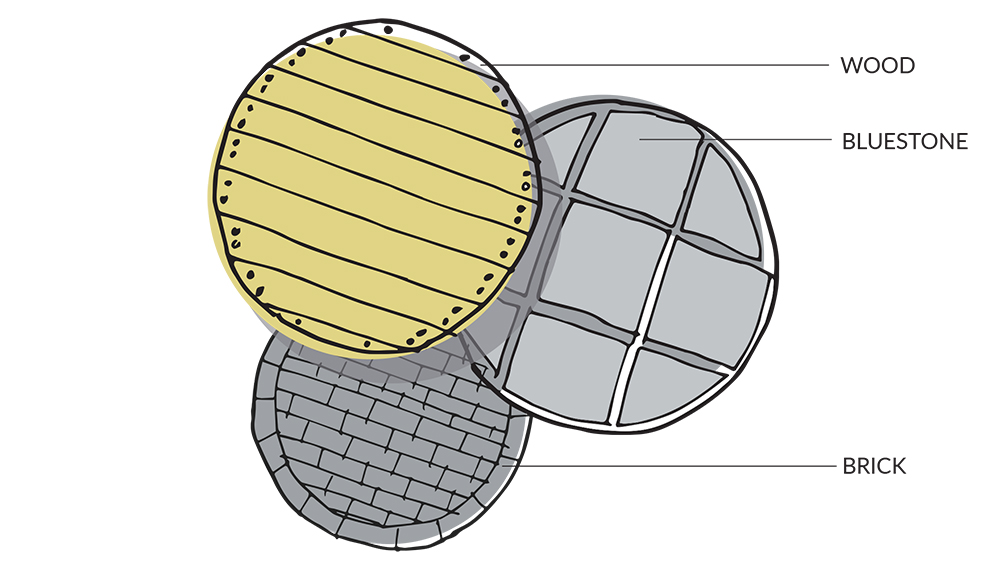
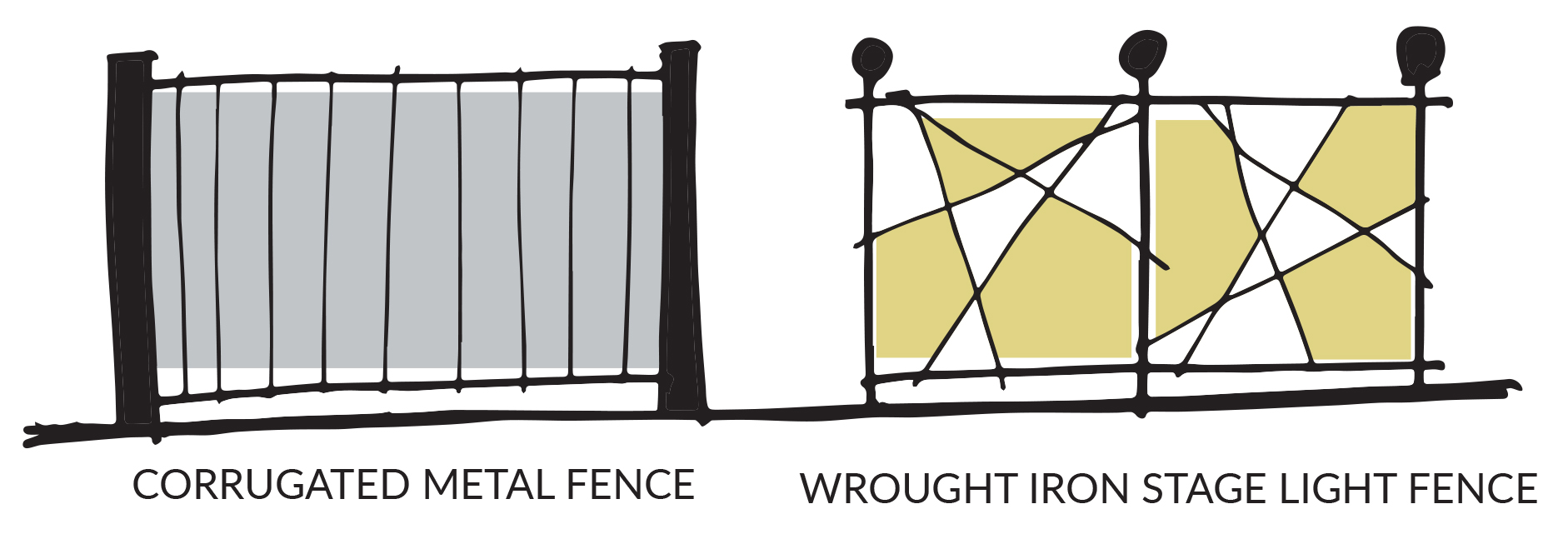
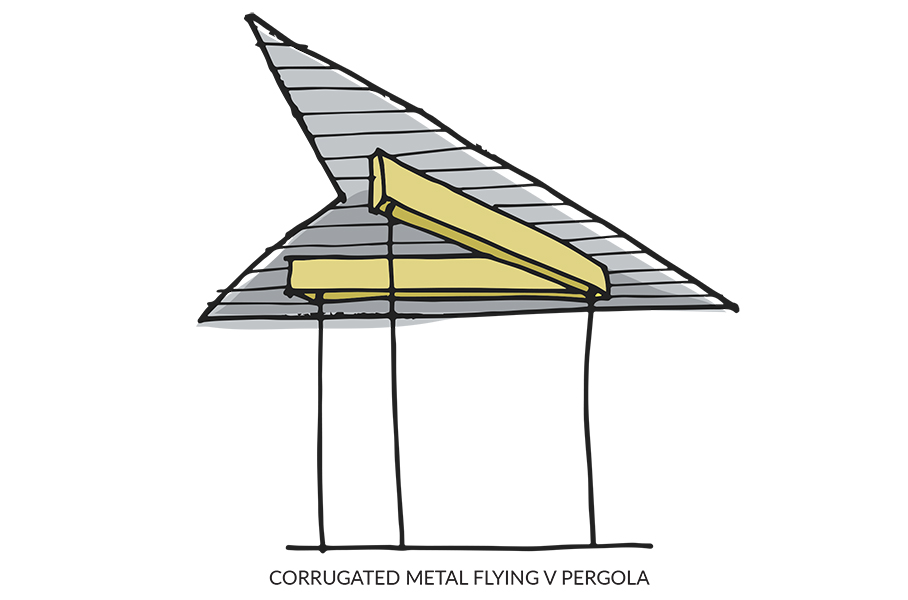
FURNITURE
Now it’s time to dress up our space with some cozy furniture. This is a great way to extend your garden into something livable.
Using our lists as inspiration once again use the shapes, colors, and possible other words and objects to assist in the selection of chairs, benches, and tables.
Your furniture can be a little crazy or simply paint a traditional item one of your theme colors.
Looking back at our brainstorming and research lists I've compiled the words below to inspire my selection of garden furniture:
Of course, our colors: gray/silver, black and yellow/gold
Plus, shiny metal, jeans, leather, drums, anvils, wrought iron, guitars, periodic table (grid), late 60s or early 70s style, chains.
Some possibilities for furniture inspired by these ideas might include:

I love the idea of wrought iron or shiny metal, so included a lot of ideas in that direction, but you can go any angle you wish.
.....
ORNAMENTATION
Garden ornament is the frosting on the cake.
These are the details that make your space extra-special like lighting, containers, art, mirrors, banners, and fountains.
Please, please keep it simple. Choose one or two special ornaments so that the final result is focused. Too many items will make your space chaotic and ultimately uncomfortable.
As with the other steps, take a look at our brainstorming and research lists to see if anything might inspire a fabulous selection of garden ornament. This is what popped into my head:
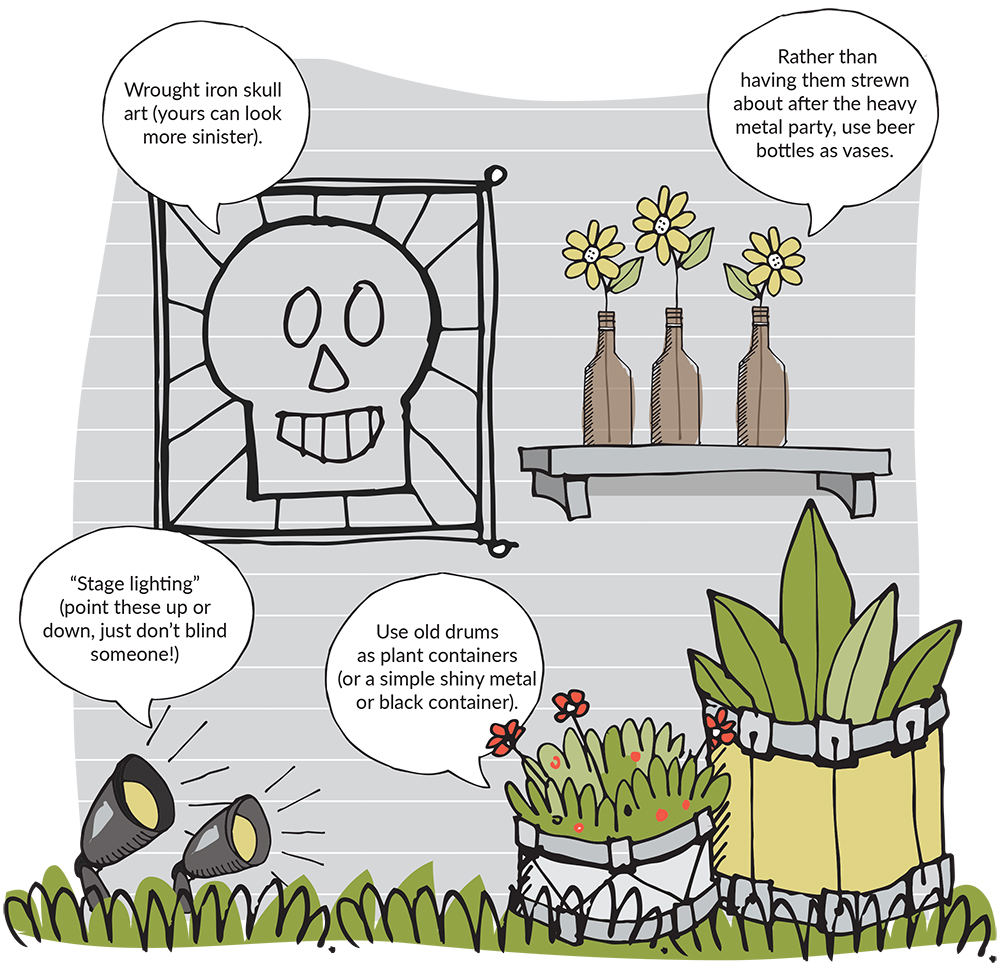
Yes, it seems that I can make heavy metal "cute", though that is not my intent (I just can't control myself). I'm sure you can come up with many more ideas, but hopefully this provides a good start. I do want to stress again that's it's important to keep it simple. You may have tons of ideas, but focus on the ones that best illustrate your theme (and are within your budget).
.....
PLANT MATERIALS
This is my favorite part!
There are thousands of plants, but having a theme and understanding your site will help whittle down your choices. Please always consider your zone, whether the site is shady, sunny, wet or dry, plus soil quality.
To choose plants that reflect your theme think about:
1. Were there any specific plants actually mentioned in our brainstorming and research lists? There were not any mentioned in our lists, but someone did say to me that roses are often used as a symbol for heavy metal bands. Cool.
2. Where there any shapes mentioned that could be reflected in plant materials? We had circles, rectangles, and v-shapes. Are there plants with these strong shapes?
3. Choose plants based on our color palette. Our color choices were black, gray and yellow. This is often the easiest plant path to follow.
4. Choose plants that have cultivar names that reflect our theme. In our case maybe we can use Panicum virgatum 'heavy metal' (an ornamental grass) and Allium 'hair' (love it!).
I focused mostly on #3 and #4, plus #1 when making my partial list below. I have a lot of yellow and gray plants, plus threw in some theme names....like moonshine, knock-out and thriller (from those big heavy metal after-parties). I also considered textures, height, form, and bloom times.
Below are some plants that we can use for our heavy metal garden (mine is a sunny location). There are many more possibilities, but I hope this will give you a good overview of how to start your own plant list.
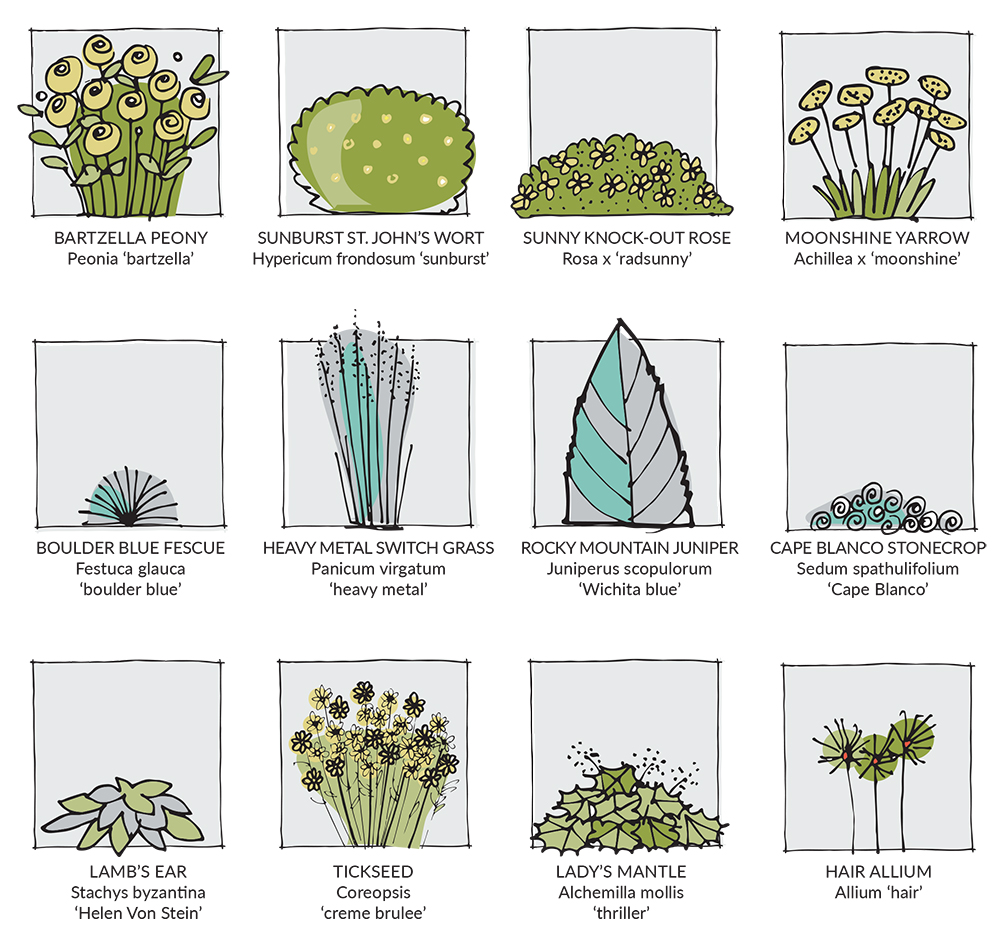
STEP FIVE | CREATE THE PLAN
All those fabulous colors, hardscapes, furniture, garden ornaments, and plant materials will now merge to create a special space.
Just for fun I've made two garden plans below. Of course, there are hundreds of possible combinations and I hope you have many other ideas to make your heavy metal garden special.
Some design hints...
Rather than just plopping elements into your garden, think about how you can create a nice space or outdoor room.
Make sure lawn, patios and bed spaces are all purposeful...not just leftover spaces. They should all have strong shapes.
Most importantly, keep your design simple. Don’t try to incorporate all your ideas. Focus on the ones that make the most sense for your garden.
PLAN ONE
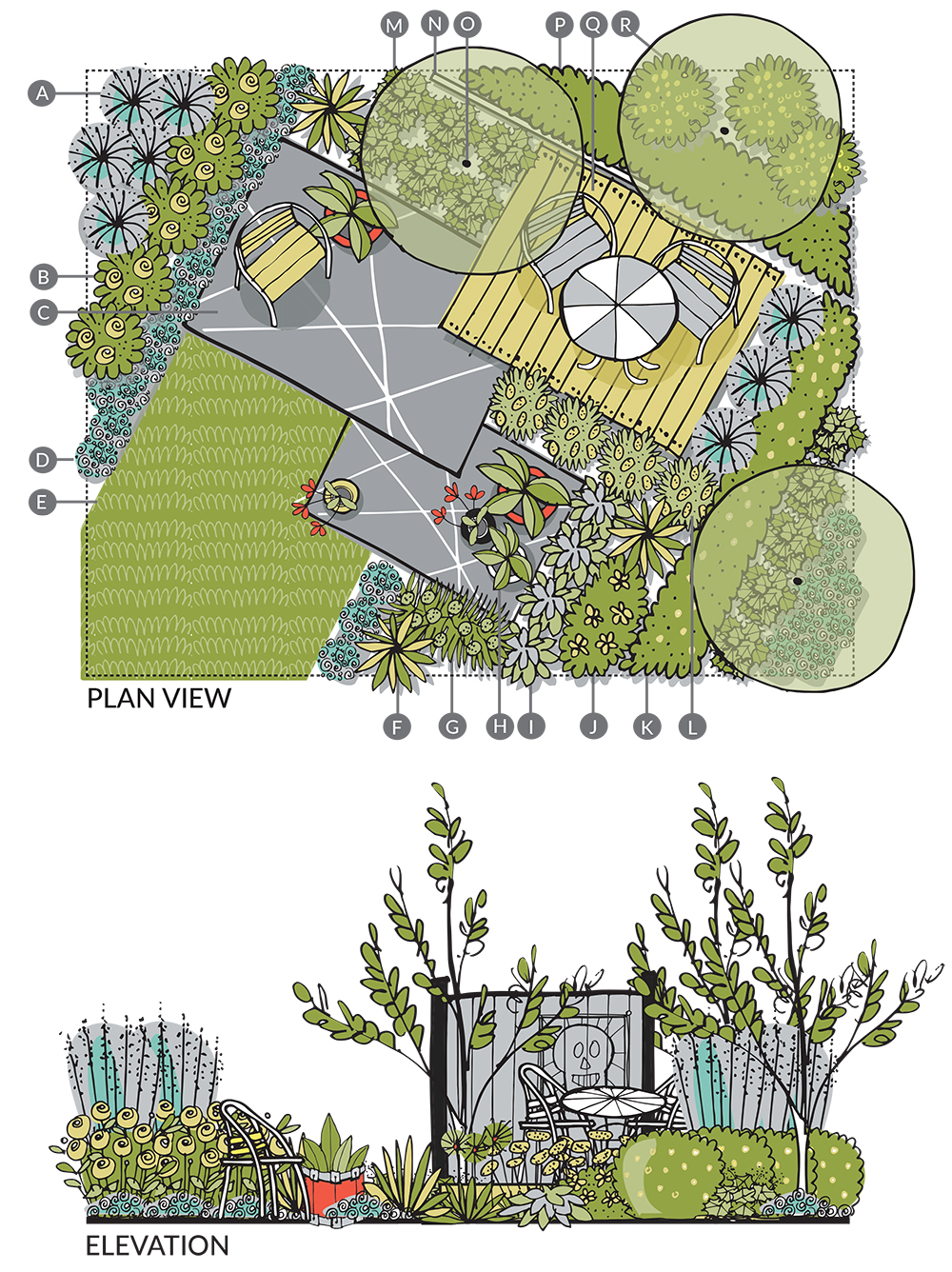
PLANT KEY
A. Panicum virgatum ‘heavy metal’ (Heavy Metal Switch Grass)
B. Peonia ‘bartzella’ (Bartzella Peony)
C. Concrete Patio (with stage lighting pattern)
D. Sedum spathulifolium ‘Cape Blanco’ (Cape Blanco Stonecrop)
E. Lawn
F. Yucca filamentosa ‘golden sword’ (Golden Sword Yucca)
G. Allium ‘hair’ (Hair Allium)
H. Drum Planters
I. Stachys byzantina ‘Helen Von Stein’ (Lamb's Ears)
J. Rosa x ‘radsunny’ (Sunny Knock-Out Rose)
K. Hypericum frondosum ‘sunburst’ (Sunburst St. John's Wort)
L. Yarrow x ‘moonshine’ (Moonshine Yarrow)
M. Alchemilla mollis ‘thriller’ (Lady's Mantle)
N. Corrugated Metal Fence
O. Magnolia acuminata ‘butterflies’ (Butterflies Magnolia)
P. Buxus sempervirens (Boxwood)
Q. Wood Patio
R. Forsythia viridissima var. koreana ‘kumson’ (Kumson Forsythia)
DO YOU SEE HOW I INCORPORATED MY THEME ELEMENTS INTO PLAN ONE?
-
The rectangle patio represents music posters and the lines in the concrete represent stage light rays.
-
The three patios are linked like a chain, plus represent heavy metal's trifecta of speed, power and precision.
-
The furniture incorporates our colors, has a shiny heavy metal sparkle, plus the table is round like a drum.
-
The planters are recycled drums.
-
The fence is corrugated, shiny metal, plus includes our skull art in wrought iron.
-
All the plants are in our color palette (yellow and gray with a hint of red from battle jackets).
-
Everything is clean and simple reminiscent of late 1960s/early 1970s landscape style (when heavy metal was born).
PLAN TWO
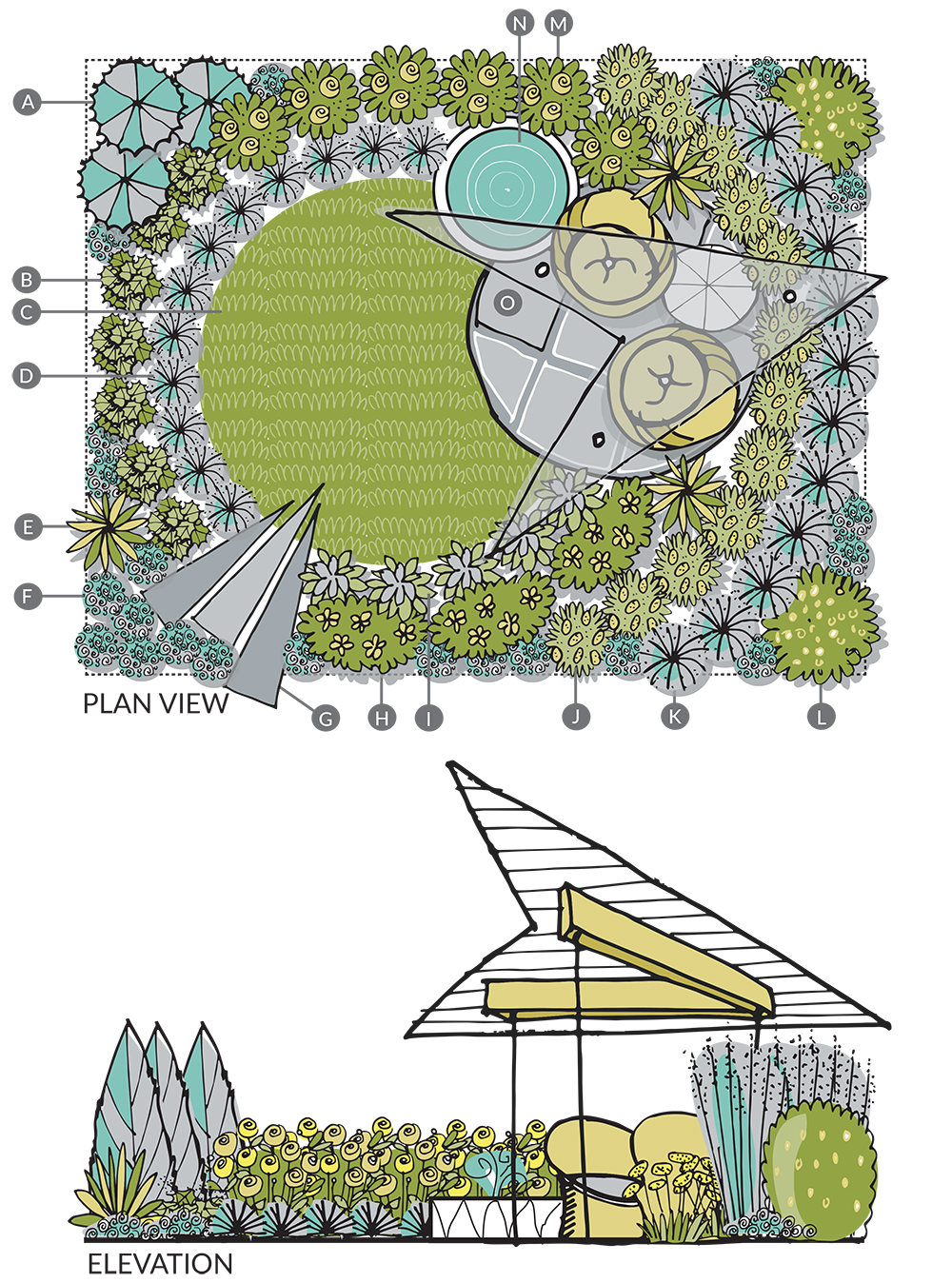
PLANT KEY
A. Juniperus scopulorum 'Wichita blue' (Wichita Blue Juniper)
B. Alchemilla mollis ‘thriller’ (Lady's Mantle)
C. Lawn
D. Festuca glauca 'boulder blue' (Boulder Blue Fescue)
E. Yucca filamentosa ‘golden sword’ (Golden Sword Yucca)
F. Sedum spathulifolium ‘Cape Blanco’ (Cape Blanco Stonecrop)
G. Bluestone shard walkway
H. Rosa x ‘radsunny’ (Sunny Knock-Out Rose)
I. Stachys byzantina ‘Helen Von Stein’ (Lamb's Ears)
J. Yarrow x ‘moonshine’ (Moonshine Yarrow)
K. Panicum virgatum ‘heavy metal’ (Heavy Metal Switch Grass)
L. Forsythia viridissima var. koreana ‘kumson’ (Kumson Forsythia)
M. Peonia ‘bartzella’ (Bartzella Peony)
N. Drum fountain
O. Bluestone patio with flying v pergola overhead
DO YOU SEE HOW I INCORPORATED MY THEME ELEMENTS iNTO PLAN TWO?
-
Three interconnected circles, the lawn, patio and fountain represent drums, an interconnected chain, plus heavy metal's trifecta of speed, power and precision.
-
Bluestone is used to incorporate our gray (silver!) color.
-
The furniture incorporates our colors, plus are round like a drum.
-
The pergola is shaped like a flying V guitar.
-
There are a lot of sharp edges in the plants, pergola and entry walk, representing the edginess of heavy metal.
-
All the plants are in our color palette (yellow and gray).
-
Do you see any other connections to heavy metal?
Thank you for taking on this adventure with me! I hope you enjoyed this super fun garden design planning process. Now its time to explore themes that connect to your soul and grows your garden design in a special way. To get started, grab my free theme garden ebook: The Peanut Butter + Jelly Garden. Do you need even more inspiration? Check out how I created a KNITTING GARDEN HERE . Enjoy!






